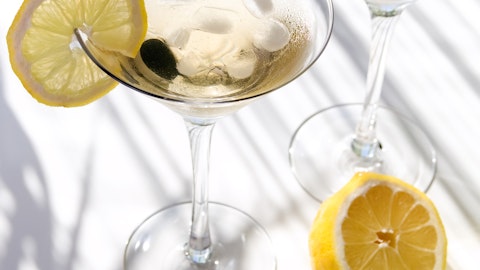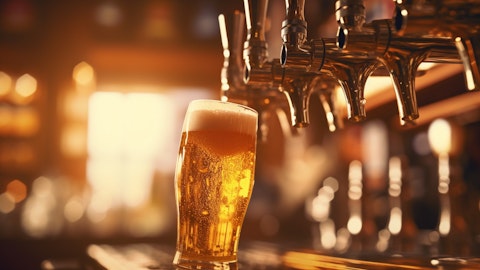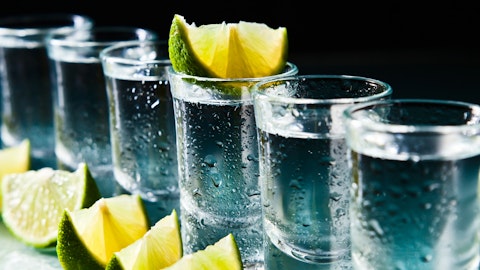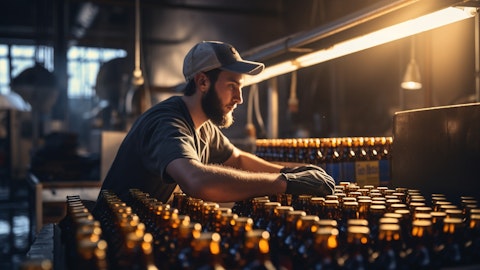Filippo Falorni: Hey, good evening, guys. A quick question, Dave. You mentioned in the prepared remarks that you expect hard seltzer category to decline at a low teens rate in 2024. You also mentioned a lot of initiatives in Truly. So are you expecting truly to grow in line with the category to gain share. And then longer term, when do you think we’re going to see kind of a new moderation or like a normalization into hard seltzer category? Do you think it’s something that could happen the tail end of ’24, maybe ’25. Just a sense of how you see hard seltzer evolving from here?
David Burwick: Sure. I think if you look at — so last year, the category was maybe down minus 20%, minus 21 is something like that in volume. We are seeing improvements, gradual but improvements. I think the latest 13 might be minus 14%. So we’re thinking minus 10% to minus 15%, probably the category. I’ve seen projections that are more optimistic than that, but I wouldn’t necessarily go there, like low single-digit declines, low to mid-single-digit declines, but it is improving a bit. For Truly, we’re now almost a year into the journey of kind of redefining what we want the brand to stand for. And the brand really is going to stand for lightly flavor variety and not the bold flavor as much because bold is a part of the category, but it’s not nearly as big as we thought it would be.
So we have made progress, I mentioned in the opening remarks, I think a year ago, it was — the business was 65% weighted toward bold flavors and 35 light. Now it’s in favor of light 55, 45. So we’re making that move. And if you look at just our life flavor SKUs, including our single-serve packages, we’re actually — our sales were up 9% year-to-date. So that part of our business, again, is it’s 45% of our business, but it’s up 9%. So we’re getting validation that people want lighter flavors. And by the way, we do this 3x a year. We call it a rotator. It’s one UPC, 3x a year. And in the past, they’ve been all bold flavors. We moved to all light starting last summer with Runway and True. The celebration pack was in T3 and T1 is to get away pack,and we’re seeing much better response.
We’re seeing very good repeat we’re bringing about 10% of the new consumers that come in, come through that. So the last thing I’ll say is we’ve paid a big push on Signal serve and convenience stores, it’s up 23% year-to-date. And it’s basically light-frame versus pineapple, it’s Wild Berry are really driving it. And a new flavor called Citrus squeeze. So we like where we’re going. It takes — it’s going to take a patient as we turn the mix within the brand toward lighter flavors. Now having said that, let’s say, the category is minus 10% for the year versus use that as a number. We’re not going to be minus 10 that. We’re going to be — we’re not going to — we don’t expect — and certainly in our guidance, we’re not expecting to be flat here for the year.
We will be south of that maybe worse than my understanding. But for me to be happy, personally, I want to see this brand continue to deliver better growth rates, and it has been getting gradually better. So a year ago was in the low — minus low 30s, now it’s around minus 20%, minus 21%, hopefully heading south of minus 20%. So I would just say from a share perspective for the year, it’s probably unlikely we’re going to gain share with truly. But if we get into the summer and beyond, if we’re holding share starting then, then I think that would be a really good sign.
James Koch: And I would add, thinking about this long term, the fundamental factors that drove the success of Seltzer are still out there. And it is very much in tune with long-term consumer trends in alcoholic beverages, which are movement to flavors to lower-calorie drinks and sort of, and hard Seltzer is a quintessence of those. And it also represents a very drinkable refreshing alternative to beer to hard liquor to wine. It offers category benefits that you really only get in hard seltzer in just the consumption experience of interesting, varied, light, refreshing, low calories and a very drinkable poundable level of alcohol. So long term, I think we’re thinking that there can be a second act for seltzer. So very much like craft beer had.
It grew like crazy for like the first 12 years. This category was started in ’84, and then it had a flat period for some years. And then it’s, I think, quadrupled when it started growing again in 2004. So I think we’ve just seen the first act for this hard Seltzer’s space. And the last thing I’d add is, and it’s a category where you have two strong creative players, us and Marc Anthony, very committed to it. and who see a long-term future if we can innovate around new consumer needs and occasions.
Filippo Falorni: Great. Thank you, guys. And best of luck, Dave.
Operator: There are no further questions at this time. And now I would like to turn the floor back over to Jim Cook for any closing comments.
James Koch: I want to thank you all for joining with us, and thank you for your main thoughts about Dave, who has done an outstanding job here. When he joined, we were $850 million, and now we’re over $2 billion. So that’s pretty damn good in six years. So thank you, Dave, and we’ll talk in a couple of months.
Operator: This concludes today’s teleconference. You may disconnect your lines at this time. Thank you for your participation.



